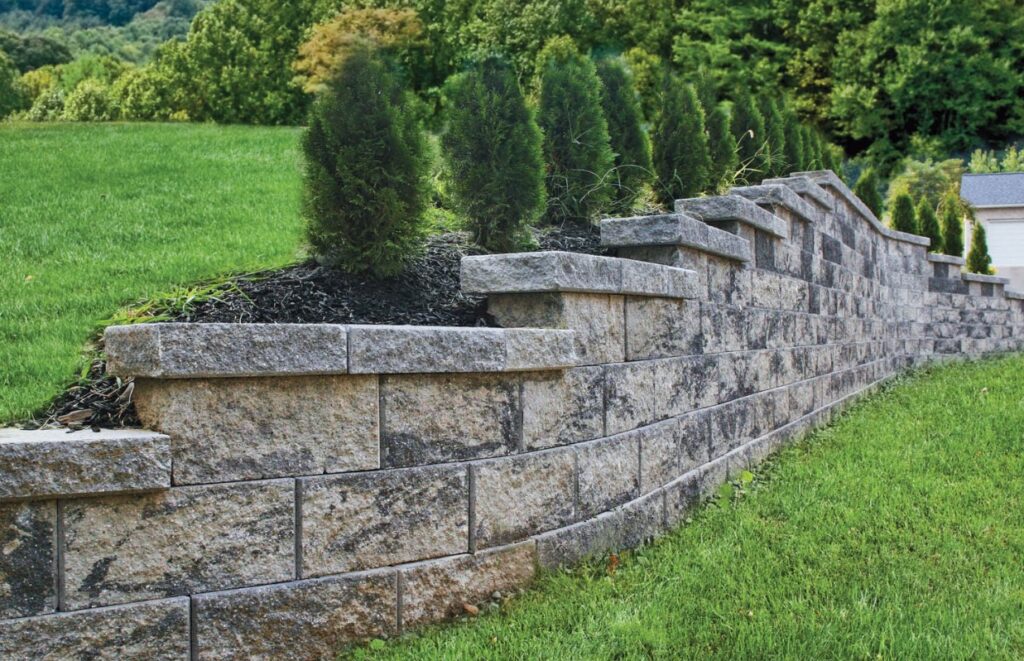This article will explain Are Retaining Walls Covered By Insurance? The answer largely depends on the specifics of your insurance policy and the circumstances leading to the damage. Retaining walls, critical for managing soil and water flow in many landscapes, often raise questions about their coverage under insurance policies.
Key Takeaways
- Coverage varies based on policy details and damage causes.
- Standard homeowner policies may offer limited coverage.
- Additional riders or policies might be needed for full protection.
- Regular maintenance is crucial to ensure coverage.
Are Retaining Walls Covered By Insurance?
Insurance coverage for retaining walls typically depends on several factors. Here’s a simple explanation:

- Coverage Depends on the Policy: Your homeowner’s insurance might cover the retaining wall if it’s damaged by something the policy includes, like a tree falling, lightning, or a pipe bursting.
- Detached Structure Coverage: Retaining walls are often seen as separate structures. So, damage to them could be covered under your policy in certain situations, like fire or storm damage.
- Limits and Conditions Apply: Even if retaining walls are included, there might be limits. For example, they might only be covered up to 10% of what your home is insured for.
- Check for Specific Exclusions: Sometimes policies say they won’t cover retaining walls. So, it’s important to read your policy or ask your insurance agent to make sure.
Understanding Your Homeowner’s Insurance Policy
Policy Coverage Specifics
Every homeowner’s insurance policy has unique terms and conditions. Generally, these policies cover structures on your property, which may include retaining walls. However, the extent of the coverage and the types of damages covered can vary greatly. It’s essential to read your policy carefully or consult with your insurance agent to understand the specifics.
Exclusions and Limitations
Typically, insurance policies have exclusions and limitations. For instance, damages caused by natural wear and tear, poor maintenance, or intentional acts are often not covered. Understanding these exclusions is crucial to assess the level of protection your retaining wall has under your current policy.
Factors Affecting Insurance Coverage for Retaining Walls
Cause of Damage
The cause of damage to a retaining wall is a critical factor in determining insurance coverage. Commonly covered perils include vandalism, vehicle impact, and certain weather-related events. However, damage due to earth movement, such as landslides or earthquakes, is often excluded unless specific additional coverage is purchased.
Type of Retaining Wall
The material and construction type of the retaining wall can also influence insurance coverage. For example, walls built with certain durable materials or professionally installed might be more likely to be covered compared to DIY or temporary structures.
Additional Insurance for Retaining Walls

Riders and Endorsements
In cases where standard homeowner’s insurance provides limited coverage, homeowners may consider purchasing additional riders or endorsements. These can offer more comprehensive protection for retaining walls, especially in areas prone to specific risks like landslides or flooding.
Separate Policies for High-Risk Areas
For properties in high-risk areas, separate policies might be necessary. Flood insurance or earthquake insurance, for example, can provide coverage for retaining walls damaged by these specific perils.
The Importance of Maintenance and Documentation
Keeping Up with Regular Maintenance
Regular maintenance of your retaining wall is not just crucial for its longevity but also for ensuring insurance coverage. Insurance companies may deny claims if the damage results from neglect or poor maintenance.
Documenting Your Retaining Wall
Keeping a record of the construction, maintenance, and any repairs of your retaining wall can be beneficial when filing a claim. Documentation can include photographs, receipts, and professional evaluations.
Legal Considerations and Local Regulations
Compliance with Local Building Codes
Retaining walls often fall under specific local building regulations. Ensuring that your wall complies with these codes is vital, not just for safety but also for insurance purposes.
Neighbor’s Property and Liability Issues
In cases where your retaining wall affects a neighbor’s property, legal considerations come into play. Liability coverage in your homeowner’s policy might protect if your wall causes damage to neighboring properties.
Preparing for the Unexpected: Case Studies

Analyzing Real-Life Scenarios
Examining real-life scenarios where retaining walls were damaged and the subsequent insurance claims can provide valuable insights. These case studies highlight the importance of understanding policy details and preparing for various contingencies.
Learning from Others’ Experiences
Learning from the experiences of others can guide you in making informed decisions about insuring your retaining wall. These case studies often reveal common pitfalls and best practices in retaining wall insurance coverage.
Expert Insights on Retaining Wall Insurance
Consulting with Insurance Professionals
Engaging with insurance professionals can offer tailored advice on retaining wall coverage. These experts can help navigate the complexities of insurance policies and suggest the best course of action for your specific situation.
Industry Best Practices
Understanding industry best practices for insuring retaining walls is crucial. This includes knowing the right questions to ask your insurance provider and being aware of the latest trends and updates in insurance coverage for retaining structures.
Evaluating Insurance Claims for Retaining Wall Damage
Navigating the insurance claims process for retaining wall damage can be complex. It’s important to promptly report any damage to your insurer and provide detailed information, including photographs and repair estimates. The insurer will then assess the claim, considering factors like the cause of damage and policy exclusions.
Challenges and Solutions
Homeowners often face challenges such as claim denials or insufficient payouts. In such cases, it’s advisable to seek a second opinion or hire a public adjuster. Understanding the reasons for claim denial and addressing them effectively can increase the chances of a successful claim.
Impact of Climate Change on Retaining Wall Insurance

Increasing Risks
Climate change is leading to more extreme weather events, which can increase the risk of damage to retaining walls. This change is prompting insurance companies to reassess their coverage policies and, in some cases, increase premiums or alter coverage terms.
Adapting Insurance Policies
It’s vital for homeowners to adapt their insurance policies in response to these changes. This might involve updating coverage limits, adding specific riders for natural disasters, or even considering specialized insurance products that cater to climate-related risks.
Financial Considerations in Insuring Retaining Walls
Cost-Benefit Analysis
When considering additional insurance for a retaining wall, homeowners should conduct a cost-benefit analysis. This involves weighing the cost of extra premiums against the potential financial impact of a retaining wall failure, especially in high-risk areas.
Insurance as an Investment
Investing in comprehensive insurance can be viewed as a safeguard against significant financial loss. In the event of damage, having adequate coverage can mitigate the expenses of repair or reconstruction, which can be substantial.
Legal Responsibilities and Retaining Wall Insurance
Understanding Homeowner Liability
Homeowners have legal responsibilities regarding the safety and maintenance of their retaining walls. Failure to adhere to these responsibilities can lead to liability issues, especially if the wall poses a risk to neighboring properties or public spaces.
Insurance as a Legal Shield
Having the right insurance coverage can provide legal protection in case of disputes or lawsuits related to retaining wall damage. This coverage can include legal defense costs and any settlements or judgments, up to the policy limits.
Future Trends in Retaining Wall Insurance

Industry Innovations
The insurance industry is continuously evolving, with new products and coverage options emerging. Innovations like usage-based insurance or coverage tailored to specific environmental risks are becoming more prevalent.
Staying Informed
Homeowners should stay informed about the latest trends and updates in retaining wall insurance. Regularly reviewing and updating insurance policies ensures that coverage remains adequate and relevant to current risks and regulations.
Conclusion
In conclusion, whether retaining walls are covered by insurance largely depends on the specifics of your policy and the cause of the damage. It’s crucial to review your homeowner’s insurance policy and understand the exclusions and limitations regarding retaining walls.
In some cases, additional riders or separate policies may be necessary for full coverage. To ensure adequate protection for your retaining walls, consulting with your insurance agent for personalized advice is advisable.
Top FAQ’s
Does homeowner’s insurance cover retaining wall collapse?
Homeowner’s insurance may cover a retaining wall collapse if it’s caused by a covered peril like vandalism or specific weather events. However, coverage is not guaranteed for all scenarios, especially if the collapse is due to excluded causes like earth movement or poor maintenance.
Are retaining walls covered under flood insurance?
Retaining walls are generally not covered under standard flood insurance policies. These policies typically exclude structures like retaining walls, sea walls, and similar constructions.
Can I get insurance for a retaining wall in a high-risk landslide area?
Yes, but it may require a specialized insurance policy or rider. Standard homeowner’s policies often exclude landslide damage, so additional coverage is necessary in high-risk areas.
How do insurance companies assess retaining wall damage?
Insurance companies assess retaining wall damage by examining the cause of damage, the extent of the damage, and compliance with maintenance and local building codes. They may also consider the age and construction quality of the wall.
What steps should I take if my insurance claim for retaining wall damage is denied?
If your claim is denied, review the insurer’s reasons, gather additional evidence or documentation, and consider appealing the decision. Consulting with a public adjuster or legal professional can also be beneficial.
A multifaceted professional, Muhammad Daim seamlessly blends his expertise as an accountant at a local agency with his prowess in digital marketing. With a keen eye for financial details and a modern approach to online strategies, Daim offers invaluable financial advice rooted in years of experience. His unique combination of skills positions him at the intersection of traditional finance and the evolving digital landscape, making him a sought-after expert in both domains. Whether it’s navigating the intricacies of financial statements or crafting impactful digital marketing campaigns, Daim’s holistic approach ensures that his clients receive comprehensive solutions tailored to their needs.









